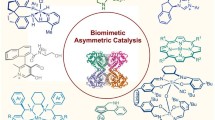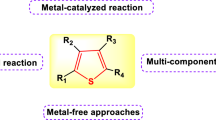Abstract
A small library of 30 thiomarinol analogues was successfully synthesised using as a key step–a catalytic enantioselective tandem oxa[4+2] cycloaddition/aldehyde allylboration methodology. With this method, highly substituted \(\alpha \)-hydroxyalkyl dihydropyrans were assembled in a single three-component reaction utilizing three different enol ethers and a wide variety of aldehydes, such as aromatic, heteroaromatic, unsaturated and aliphatic aldehydes. In a second operation, a mild and direct method for reducing an acetal unit in the \(\alpha \)-hydroxyalkyl dihydropyrans was optimised without the need for protecting a nearby hydroxyl group. This procedure facilitated the synthetic sequence, which was completed by a dihydroxylation of the residual olefin of \(\alpha \)-hydroxyalkyl 2\(H\)-pyrans to provide the desired library of dihydroxylated pyran analogues reminiscent of the thiomarinol antibiotics. The relative stereochemistry of the resulting library compounds was demonstrated by X-ray crystallography on one of the analogues.
Graphical Abstract









Similar content being viewed by others
References
Sutherland R, Boon RJ, Griffin KE, Masters PJ, Slocombe B, White AR (1985) Antibacterial activity of mupirocin (pseudomonic acid), a new antibiotic for topical use. Antimicrob Agents Chemother 27:495–498
Badder A, Garre C (1887) Title. Corresp Bl Sweiz Aertze 17:385
Fuller AT, Mellows G, Woolford M, Banks GT, Barrow KD, Chain EB (1971) Pseudomonic acid—antibiotic produced by Pseudomonas fluorescens. Nature 234:416–416. doi:10.1038/234416a0
Chain EB, Mellows G (1977) Pseudomonic acid. 3. Structure of pseudomonic acid B. J Chem Soc Perkin Trans 1:318–322. doi:10.1039/p19770000318
Alexander RG, Clayton JP, Luk K, Rogers NH, King TJ (1978) Chemistry of pseudomonic acid. 1. Absolute configuration of pseudomonic acid A. J Chem Soc Perkin Trans 1:561–565. doi:10.1039/p19780000561
Hughes J, Mellows G (1978) Inhibition of isoleucyl transfer ribonucleic acid synthetase in Escherichia coli by pseudomonic acid. Biochem J 176:305–318
Hughes J, Mellows G (1978) Mode of action of pseudomonic acid—inhibition of protein synthesis in Staphylococcus aureus. J Antibiot 31:330–335
Hughes J, Mellows G, Soughton S (1980) How does Pseudomonas fluorescens, the producing organism of the antibiotic pseudomonic acid A, avoid suicide. FEBS Lett 122:322–324. doi:10.1016/0014-5793(80)80465-0
Silvian LF, Wang J, Steitz TA (1999) Insights into editing from an Ile-tRNA synthetase structure with tRNA(Ile) and mupirocin. Science 285:1074–1077. doi:10.1126/science.285.5430.1074
Class YJ, DeShong P (1995) The pseudomonic acids. Chem Rev 95:1843–1857. doi:10.1021/cr00038a005
Clayton JP, Oliver RS, Rogers NP, King TJ (1979) Chemistry of pseudomonic acid 3. Rearrangement of pseudomonic acid A in acid and basic solution. J Chem Soc Perkin Trans I 838–846. doi:10.1039/p19790000838
Shiozawa H, Kagasaki T, Kinoshita T, Haruyama H, Domon H, Utsui Y, Kodama K, Takahashi S (1993) Thiomarinol, a new hybrid antimicrobial antibiotic produced by a marine bacterium fermentation, isolation, structure, and antimicrobial activity. J Antibiot 46:1834–1842
Stierle DB, Stierle AA (1992) Pseudomonic acid derivatives from a marine bacterium. Experientia 48:1165–1169. doi:10.1007/BF01948016
Shiozawa H, Takahashi S (1994) Configurational studies on thiomarinol. J Antibiot 47:851–853
Shiozawa H, Kagasaki T, Torikata A, Tanaka N, Fujimoto K, Hata T, Furukawa Y, Takahashi S (1995) Thiomarinol B and thiomarinol C, new antimicrobial antibiotics produced by a marine bacterium. J Antibiot 48:907–909
Gao X, Hall DG (2005) Catalytic asymmetric synthesis of a potent thiomarinol antibiotic. J Am Chem Soc 127:1628–1629. doi:10.1021/ja042827p
Marion O, Gao X, Marcus S, Hall DG (2009) Synthesis and preliminary antibacterial evaluation of simplified thiomarinol analogs. Bioorg Med Chem 17:1006–1017. doi:10.1016/j.bmc.2008.01.001
Breinbauer R, Vetter IR, Waldmann H (2002) From protein domains to drug candidates—natural products as guiding principles in the design and synthesis of compound libraries. Angew Chem Int Ed 41:2878–2890. doi:10.1002/1521-3773(20020816)41:16<2878:AID-ANIE2878>3.0.CO;2-B
Gao X, Hall DG (2003) 3-Boronoacrolein as an exceptional heterodiene in the highly enantio- and diastereoselective Cr(III)-catalyzed three-component [4+2]/allylboration. J Am Chem Soc 125:9308–9309. doi:10.1021/ja036368o
Chavez DE, Jacobsen EN (2005) An efficient, highly diastereo- and enantioselective hetero-Diels–Alder catalyst. Preparation of (2S,6R)-6-(tert-butyldimethyl-siloxymethyl)-2-methoxy-2,5-dihydropyran. Org Synth 82:34
Gademann K, Chavez DE, Jacobsen EN (2002) Highly enantioselective inverse-electron-demand hetero-Diels–Alder reactions of alpha, beta-unsaturated aldehydes. Angew Chem Int Ed 41:3059–3061. doi:10.1002/1521-3773(20020816)41:16<3059:AID-ANIE3059>3.0.CO;2-I
Evans DA, Andrews GC, Buckwalter B (1974) Metalated allylic ethers as homoenolate anion equivalents. J Am Chem Soc 96:5560–5561. doi:10.1021/ja00824a039
Yamamoto H, Tsuda M, Sakaguchi S, Ishii Y (1997) Selective oxidation of vinyl ethers and silyl enol ethers with hydrogen peroxide catalyzed by peroxotungstophosphate. J Org Chem 62:7174–7177. doi:10.1021/jo970440h
Gao X, Hall DG, Deligny M, Favre A, Carreaux F, Carboni B (2006) Catalytic enantioselective three-component hetero-[4+2] cycloaddition/allylboration approach to alpha-hydroxyalkyl pyrans: scope, limitations, and mechanistic proposal. Chem Eur J 13:3132–3142. doi:10.1002/chem.200501197
Li X, Uchiyama T, Raetz CRH, Hindsgaul O (2003) Synthesis of a carbohydrate-derived hydroxamic acid inhibitor of the bacterial enzyme (LpxC) involved in lipid A biosynthesis. Org Lett 5:539–541. doi:10.1021/ol027458l
Rolf D, Gray GR (1982) Reductive cleavage of glycosides. J Am Chem Soc 104:3539–3541. doi:10.1021/ja00376a065
Debenham SD, Toone EJ (2000) Regioselective reduction of 4,6-O-benzylidenes using triethylsilane and \(\text{ BF }_{3}\) center dot \(\text{ Et }_{2}\)O. Tetrahedron: Asymmetry 11:385–387. doi: 10.1016/S0957-4166(99)00584-4
Lipták A, Jodál I, Nánási P (1975) Stereoselective ring-cleavage of 3-O-benzyl-4,6-O-benzylidenehexopyranoside and 2,3-di-O-benzyl-4,6-O-benzylidenehexopyranoside derivatives with \(\text{ LiAlH }_{4}\)–\(\text{ AlCl }_{3}\) reagent. Carbohydr Res 44:1–11. doi: 10.1016/S0008-6215(00)84330-X
Garegg PJ, Hultberg H, Wallin S (1982) A novel, reductive ring-opening of carbohydrate benzylidene acetals. Carbohydr Res 108:97–101
Deninno MP, Etienne JB, Duplantier KC (1995) A method for the selective reduction of carbohydrate 4,6-O-benzylidene acetals. Tetrahedron Lett 36:669–672. doi:10.1016/0040-4039(94)02348-F
Balakumar V, Aravind A, Baskaran S (2004) A highly regio- and chemoselective reductive cleavage of benzylidene acetals with \(\text{ EtAlCl }_{2}\)–\(\text{ Et }_{3}\)SiH. Synlett 647–650: doi:10.1055/s-2004-817752
Zhang HX, Xia P, Zhou WS (2003) Novel asymmetric total synthesis of the natural (+)-6-epicastanospermine. Tetrahedron 59:2015–2020. doi:10.1016/S0040-4020(02)01258-9
Deligny M, Carreaux F, Carboni B, Toupet L, Dujardin G (2003) A novel diastereoselective route to alpha-hydroxyalkyldihydropyrans using a hetero Diels–Alder/allylboration sequence. Chem Commun 276–277. doi:10.1039/b208572k
Deligny M, Carreaux F, Toupet L, Carboni B (2003) Efficient asymmetric synthesis of 2,6-disubstituted 2H-dihydropyrans via a catalytic hetero-Diels–Alder/allylboration sequence. Adv Synth Catal 345:1215–1219. doi:10.1002/adsc.200303127
Acknowledgments
The authors thank the Natural Sciences and Engineering Research Council (NSERC) of Canada and the University of Alberta for financial support of this research.
Author information
Authors and Affiliations
Corresponding author
Electronic supplementary material
Below is the link to the electronic supplementary material.
Rights and permissions
About this article
Cite this article
Al-Zoubi, R.M., Hall, D.G. Catalytic enantioselective diversity-oriented synthesis of a small library of polyhydroxylated pyrans inspired from thiomarinol antibiotics. Mol Divers 18, 701–719 (2014). https://doi.org/10.1007/s11030-014-9542-6
Received:
Accepted:
Published:
Issue Date:
DOI: https://doi.org/10.1007/s11030-014-9542-6




